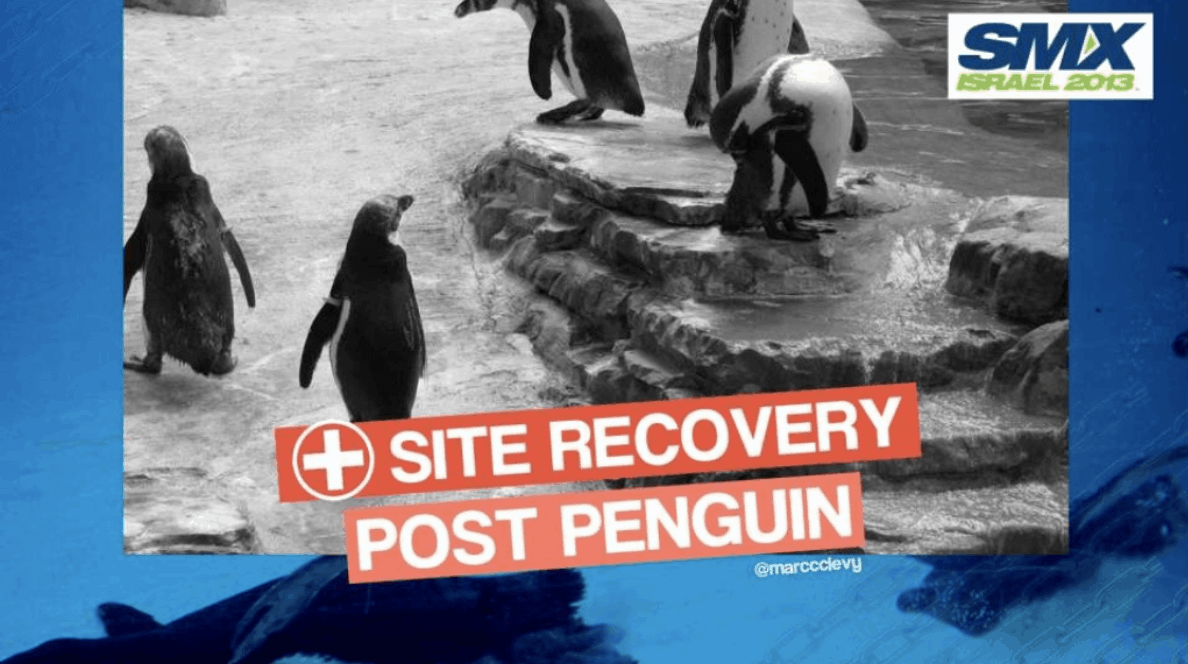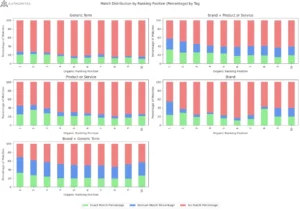On Sunday 6th January, Marc Levy spoke at SMX Israel. Below is the slide deck complete with a full transcript of the talk. Also, we wrote a post on 121 tips from #SMX Israel 2013 which you may find useful 🙂
Marc Levy: Post Penguin Recovery
Many people were using shady link building tactics prior to Googles Penguin update, this presentation is going to take you through the clean up and recovery process.

Step one: You need to do some diagnosis. The first thing you want to look at is did you do all the shit Jim just told you not to? (old school link building tactics like, tons of directory submissions, social bookmarks, links from networks, strong use of money anchor text etc). If you did, and a lot of you probably did, then you’re going to need to do some work. You’ve probably had some sort of penalty or negative filter already, or there’s a good chance you’re going to get one moving forward as we can be sure of more Penguin updates moving through 2013. In any case, at a minimum you’re probably going to want to do some pre-emptive link cleanup.
Two: Did you lose rankings or traffic during a Penguin update. This is quite easy to check. Check analytics, looking for traffic drops or check your ranking reports looking for drops . Did a loss in any of this correlate with the dates in and around a Penguin update? (You can check the dates of Penguin here) If you do see a drop around those dates then it’s probably Penguin and it’s an algorithmic penalty. In this instance, you’re going to have to do some link cleanup, and probably, submit a disavow file.
Three: Did you get the dreaded Webmaster Tools email about unnatural links? This is the clearest sign that you’ve got some of penalty. It’s going to be manual, and you’re probably going to have to submit a re-inclusion request in order to recover.

In any case, if your site falls into any of the categories mentioned previous, you’re going to have to start cleaning up your links.

In order to start cleaning up the first thing we need to do is gather as much data up as possible.
We’re going to use some tools for this – Google have come out and said that the only tool you need in order to cleanup your backlinks effectively is Webmaster Tools. However, I suggest that if you’ve got the money or the resources, use as many of the other tools listed as well. Something Webmaster Tools isn’t showing today might show tomorrow, so if we’re going to clean up, we might as well do it properly. You’re going to want to run these tools, extracting as much link data as possible.
Also be sure to look into your own link building records – go as far back as possible! If you’ve just joined a new company, make sure that you’re asking questions, trying to get past reports. You want to get as much as you can and then create one document with all the data you have gathered, then remove duplicates in Excel. This will leave you with one large list of link information.

Next step: Determining which links are bad. This isn’t easy. You need to try and simplify that process. My recommendation to you would be create two buckets; good and bad. Keep it that simple. There’s no in between; either a link’s good or a link’s bad. If you’re mulling over a link you paid loads for, or you worked hard for and your not sure if it’s great – put it in the bad bucket!
You’re going to get the best results from reviewing your links manually, but the first step is going to be checking if all those links in your list are still live and online. You can use a tool like Screaming Frog to help you do this. There’s a link to a guide to help you do that stuff.
Next step, you’re going to want to look at the links built by you or your team first; these are probably going to be the most problematic. It’s probably a great place to start because you’ve got information on them. Hopefully, you’ll know what types of links you built as well as anchor text used. For instance, you know that in March last year, you submitted to 300 directories using one money anchor text. These links should be easy to classify and make a decision on, hopefully speeding up the process.
After that you’re going to also want to try and classify the rest of you links, if your able to quickly go through you list and categorize link types then this will also help speed things up too! Outside of that, you’re just going to have to start looking at links one by one, making a decision on whether the link is good or not.
There are also tools that can help you with this stuff. You’ve got the Link Detox Tool from Link Research Tools, RemoveEm; there’s a whole bunch. I’ve also linked to a post written by LuckyBoost, who reviewed on all these tools and has some information on each of them.

Up next is the Link removal request stage. So you’ve got your long list of bad links. What you’re going to want to do is prepare a template email, because in all likelihood, you’ll have a lot of emails to send out. My suggestion to you is to make a template, but leave some room to make it personal. That way, when you email the webmaster, at least it looks like you’re a real person and not a spam email.
You need to email everyone on the bad list. Start with the most problematic, risky links first, and work your way down. Hat tip: be sure to send follow-up emails. A lot of people don’t do this stuff, but I think it can look good in Google’s eyes a bit further down the line. Just wait a couple of days or a week. People that you haven’t heard back from or haven’t removed your links; send them another email, don’t be lazy.
Finally, keep a record of this stuff you’re doing; emails, conversations with webmasters. Make sure that you’re keeping it so you can refer to it later.

So.. you now probably need to use the Disavow tool. In October 2012, Google released the disavow tool. When this launched webmasters and SEOs were all excited at the beginning, but this soon turned into a bit of dull confusion. I’m going to talk a little bit about the tool. Not how to use it, but important tips.
First off, use this tool with CAUTION. It was the main thing that I remember Matt Cutts talking about when the tool was first released, and it actually is really important. If you put good links into this tool, they will get devalued along with your bad links. You really want to be sure you have a problem and that the links being disavowed are bad before implementing.
So.. create the disavow file – it’s really not too complicated. An important tip, though: Make sure you use comments inside the disavow tool. All that info you kept previously from your link removal attempts – mention in the comments section.
Be aware that it can take quite a long time to work. Google say it can take several weeks. I’ve already seen instances where it’s taken longer. You’re going to have to wait it out. John Mueller actually said in a Google+ thread that it was something to do with links needing to be re-indexed. Again, if you’ve got an algorithmic penalty, like Penguin, you might have to wait until there’s another Penguin update to potentially see this work.
Last really important point on this, just submitting the disavow file isn’t enough. It’s not going to cut it. Google explicitly say, “You need to actually remove links.” If you think you’re going to submit the disavow file and skip all the steps I spoke about previously, it’s probably not going to work for you. Google want to see your problematic links are coming down, and that you’re attempting to do it, so make sure you follow the steps. The tool’s pretty new and more info and findings are being published all the time. Google are obviously learning also.
Finally, and most importantly, this isn’t a ‘get out of jail free card’. I speak to a lot of people. I consult for a lot of different businesses. I’ve encountered a lot of problems to do with link building. What’s really important to remember is that your rankings aren’t going to return to where they were prior to a Penguin hit. A lot of those links that were helping you rank and get traffic back then will not be counting anymore. You need to realize that when this tool works, you’re not going to back to where you were, but you will hopefully be in a good place to move forward.

Finally, if you received that Google Webmaster Tools email, you’re going to have to submit a re-inclusion request. The biggest tip I can give you is to be as detailed as possible. You’re going to want to give Google as much information as you possibly can. Hopefully, this will help you recover.
So how is this done? Start by acknowledging your problems. Be sure to talk about the bad stuff you found, why it was implemented and who did it. Now remember earlier I said to keep a record of all your link clean up attempts? You want to make sure that you link off to as much information as you can. The large spreadsheet I spoke about, do it in Google Docs. That way, in the re-inclusion request, you can link to the actual spreadsheet, Google can then get in there and can actually see the list of emails you sent; whether you’ve succeeded in removing the links, whether any of the webmasters wrote back and said, “Sorry. We’re not going to remove it for whatever reason”.
It makes sense to mention the disavow file you submitted in the re-inclusion request, they will probably know about it, but it can’t hurt. Finally, submit and wait. This can take even longer than the several weeks that Google spoke about for the disavow. You’re going to have to wait for a Googler to manually come and review your request, make a decision on it, and come back to you.

Now start doing it right! 😛







